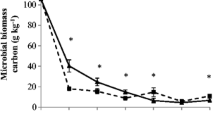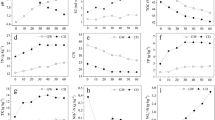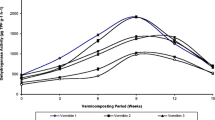Abstract
Here we studied the effects of gut transit through the earthworm Eudrilus eugeniae, on the physicochemical, biochemical, and microbial characteristics of pig slurry, by analyzing fresh casts. The reduction in the dissolved organic C contents in casts we recorded suggests that during digestion, earthworms assimilated labile organic C preferentially, which is a limiting growth factor for them. Furthermore, both microbial biomass and activity in pig slurry were significantly decreased by earthworm gut transit. It appears that E. eugeniae is able to digest microorganisms, although the addition of glucose to the food increased respiration, indicating that growth of microorganisms in casts could be limited by depletion of labile C. Despite reduced microbial biomass and activity, the metabolic diversity of microbial communities was greater in casts than in original pig slurry. Community level physiological profiles obtained from Biolog Ecoplate data revealed that, after earthworm gut transit, the microbial communities in casts and pig slurry were clearly differentiated by their physiological profiles. The results indicate that first stage in vermicomposting of pig slurry by E. eugeniae, i.e., casting, produced changes that will influence the dynamics of the organic matter degradation by reducing forms of N and C available to microorganisms, hence restricting their growth and multiplication. Nevertheless, the reduced microflora of casts was characterized by an increased catabolic potential that might lead to thorough degradation of pig slurry.

Similar content being viewed by others
References
Aira M, Monroy F, Domínguez J, Mato S (2002) How earthworm density affects microbial biomass and activity in pig manure. Eur J Soil Biol 38:7–10
Aira M, Monroy F, Domínguez J (2003) Effects of two species of earthworms (Allolobophora sp.) on soil systems: a microfaunal and biochemical analysis. Pedobiologia 47:877–881
Anderson JPE (1982) Soil respiration. In: Page AL, Miller RH (eds) Methods of soil analysis, Part 2, Chemical and microbiological properties, 2nd edn. Agronomy monograph No. 9, ASA-SSSA, Madison, pp 831–871
Bansal S, Kapoor KK (2000) Vermicomposting of crop residues and cattle dung with Eisenia foetida. Bioresour Technol 73:95–98
Benítez E, Nogales R, Elvira C, Masciandaro G, Ceccanti B (1999) Enzyme activities as indicators of the stabilization of sewage sludge composting with Eisenia fetida. Bioresour Technol 67:297–303
Bohlen PJ, Edwards CA (1995) Earthworms effects on N dynamics and soil respiration in microcosms receiving organic and inorganic nutrients. Soil Biol Biochem 27:341–348
Carreiro MM, Sinsabaugh RL, Repert DA, Parkhurst DF (2000) Microbial enzyme shifts explain litter decay responses to simulated nitrogen deposition. Ecology 81: 2359–2365
Casida LE Jr, Klevin DA, Santoro T (1964) Soil dehydrogenase activity. Soil Sci 93:371–376
Daniel O, Anderson JM (1992) Microbial biomass and activity in contrasting soil materials after passage through the gut of the earthworm Lumbricus rubellus Hoffmeister. Soil Biol Biochem 24:465–470
Devliegher W, Verstraete W (1995) Lumbricus terrestris in a soil core experiment: nutrient-enrichment processes (NEP) and gut-associated processes (GAP) and their effect on microbial biomass and microbial activity. Soil Biol Biochem 27:1573–1580
Dick RP (1992) A review: long-term effects of agricultural systems on soil biochemical and microbial parameters. Agric Ecosyst Environ 40: 25–36
Domínguez J (2004) State of the art and new perspectives on vermicomposting research. In: Edwards CA (ed) Earthworm ecology, 2nd edn. CRC, Boca Raton, pp 401–424
Domínguez J, Edwards CA (2004) Vermicomposting organic wastes: a review. In: Hanna SHS, Mikhail WZA (eds) Soil zoology for sustainable development in the 21st century, Cairo, pp 369–395
Edwards CA (2004) Earthworm ecology, 2nd edn. CRC Press, Boca Raton
Edwards CA, Bohlen PJ (1996) Biology and ecology of earthworms 3rd edn. Chapman and Hill, London
Eivazi F, Tabatabai MN (1977) Phosphatases in soils. Soil Biol Biochem 9:167–172
Eivazi F, Tabatabai MA (1988) Glucosidases and galactosidases in soils. Soil Biol Biochem 20:601–606
Fischer K, Hahn D, Amann RI, Daniel O, Zeyer J (1995) In situ analysis of the bacterial community in the gut of the earthworm Lumbricus terrestris L. by whole-cell hybridization. Can J Microbiol 41:666–673
Flegel M, Schrader S (2000) Importance of food quality on selected enzyme activities in earthworm casts (Dendrobaena octaedra, Lumbricidae). Soil Biol Biochem 32:1191–1196
Garland JL (1997) Analysis and interpretation of community-level physiological profiles in microbial ecology. FEMS Microbiol Ecol 24:289–300
Garland JL, Mills AL (1991) Classification and characterization of heterotrophic microbial communities on the basis of patterns of community-level sole-carbon-source utilization. Appl Environ Microbiol 57:2351–2359
Horn MA, Schramm A, Drake HL (2003) The earthworm gut: an ideal habitat for ingested N2O-producing microorganisms. Appl Environ Microbiol 69:1662–1669
Ibekwe AM, Kennedy AC (1998) Phospholipid fatty acid profiles and carbon utilization patterns for analysis of microbial community structure under field and greenhouse conditions. FEMS Microbiol Ecol 26:151–163
Insam H (1997) A new set of substrates proposed for community characterization in environmental samples. In: Insam H, Rangger A (eds) Microbial communities. Springer, Berlin Heidelberg New York, pp 259–260
Karsten GR, Drake HL (1995) Comparative assessment of the aerobic and anaerobic microflora of earthworm guts and forest soils. Appl Environ Microbiol 61:1039–1044
Kaushik P, Garg VK (2003) Vermicomposting of solid textile mill sludge and cow dung with the epigeic earthworm Eisenia foetida. Bioresour Technol 90:311–316
Kristufek V, Ravasz K, Pizl V (1992) Changes in densities of bacteria and microfungi during gut transit in Lumbricus rubellus and Aporrectodea caliginosa (Oligochaeta: Lumbricidae). Soil Biol Biochem 12:1499–1500
Ladd JN, Butler JHA (1972) Short-term assays of soil proteolytic enzyme activities using proteins and dipeptide derivates as substrates. Soil Biol Biochem 4:19–30
Lavelle P, Spain AV (2001) Soil Ecology. Kluwer, London
Logan NA (1994) Bacterial systematics. Blackwell, London
Moody SA, Briones MJI, Pierce TG, Dighton J (1995) Selective consumption of decomposing wheat straw by earthworms. Soil Biol Biochem 28:533–537
Nannipieri P, Grego S, Ceccanti B (1990) Ecological significance of the biological activity in soil. In: Bollag JM, Stotzky G (eds) Soil viochemistry, vol 6. Marcel Dekker, New York, pp 293–355
Nannipieri P, Ascher J, Ceccherini MT, Landi L, Pietramellara G, Renella G (2003) Microbial diversity and soil functions. Eur J Soil Sci 54:665–670
Parthasarathi K, Ranganathan LS (1999) Longevity of microbial and enzyme activity and their influence on NPK content in pressmud vermicasts. Eur J Soil Biol 35:107–113
Pedersen JC, Hendriksen NB (1993) Effect of passage through the intestinal tract of detritivore earthworms (Lumbricus spp.) on the number of selected Gram-negative and total bacteria. Biol Fertil Soils 16:227–232
Plaza C, Hernández D, García-Gil JC, Polo A (2004) Microbial activity in pig slurry-amended soils under semiarid conditions. Soil Biol Biochem 36: 1577–1585
Scheu S (1987) Microbial activity and nutrient dynamics in earthworm casts (Lumbricidae). Biol Fertil Soils 5:230–234
Scheu S (1993) Analysis of the microbial nutrient status in soil microcompartments: earthworm faeces from a basalt-limestone gradient. Geoderma 56:575–586
Scheu S, Schaefer S (1998) Bottom-up control of the soil macrofauna community in a beechwood on limestone: manipulation of food resources. Ecology 79:1573–1585
Schinner F, Von Mersi W (1990) Xylanase-, CM-cellulase- and invertase activity in soil: an improved method. Soil Biol Biochem 22:511–515
Schönholzer F, Hahn D, Zeyer J (1999) Origins and fate of fungi and bacteria in the gut of Lumbricus terrestris L. studied by image analysis. FEMS Microbiol Ecol 28:235–248
Scott JS, Knudsen GR (1999) Soil amendment effects of rape (Brassica napus ) residues on pea rhizosphere bacteria. Soil Biol Biochem 31:1435–1441
Seastedt TR, James SW, Todd TC (1988) Interactions among soil invertebrates, microbes and plant growth in the tallgrass prairie. Agric Ecosyst Environ 24:219–228
Sims GK, Ellsworth TR, Mulvaney RL (1995) Microscale determination of inorganic nitrogen in water and soil extracts. Commun Soil Sci Plant Anal 26:303–316
Tiunov AV, Scheu S (2000a) Microfungal communities in soil, litter and casts of Lumbricus terrestris L. (Lumbricidae): a laboratory experiment. Appl Soil Ecol 14:17–26
Tiunov AV, Scheu S (2000b) Microbial biomass, biovolume and respiration in Lumbricus terrestris L. cast material of different age. Soil Biol Biochem 32:265–275
Tiunov AV, Scheu S (2004) Carbon availability controls the growth of detritivores (Lumbricidae) and their effect on nitrogen mineralization. Oecologia 138:83–90
Vance ED, Brooks PC, Jenkinson DS (1987) An extraction method for measuring soil microbial biomass C. Soil Biol Biochem 19:703–707
Widmer F, Fließbach A, Laczkó E, Schulze-Aurich J, Zeyer J (2001) Assessing soil biological characteristics: a comparison of bulk soil community DNA-, PLFA-, and Biolog-analyses. Soil Biol Biochem 33:1029–1036
Wolter C, Scheu S (1999) Changes in bacterial numbers and hyphal lengths during the gut passage through Lumbricus terrestris (Lumbricidae, Oligochaeta). Pedobiologia 43:891–900
Zak JC, Willig MR, Mooread DL, Wildman HG (1994) Functional diversity of microbial communities: a quantitative approach. Soil Biol Biochem 26:1101–1108
Zhang QL, Hendrix PF (1995) Earthworm (Lumbricus rubellus and Aporrectodea caliginosa) effects on carbon flux in soil. Soil Sci Soc Am J 59:816–823
Zhang B, Li G, Shen T, Wang T, Sun Z (2000) Changes in microbial biomass C, N and P and enzyme activities in soil incubated with the earthworms Metaphire guillelmi or Eisenia fetida. Soil Biol Biochem 32:2055–2062
Acknowledgements
This research was supported by CICYT (AGL2003-01570) and Xunta de Galicia (PGIDIT03PXIB30102PR) grants.
Author information
Authors and Affiliations
Corresponding author
Rights and permissions
About this article
Cite this article
Aira, M., Monroy, F. & Domínguez, J. Changes in microbial biomass and microbial activity of pig slurry after the transit through the gut of the earthworm Eudrilus eugeniae (Kinberg, 1867). Biol Fertil Soils 42, 371–376 (2006). https://doi.org/10.1007/s00374-005-0047-4
Received:
Revised:
Accepted:
Published:
Issue Date:
DOI: https://doi.org/10.1007/s00374-005-0047-4




